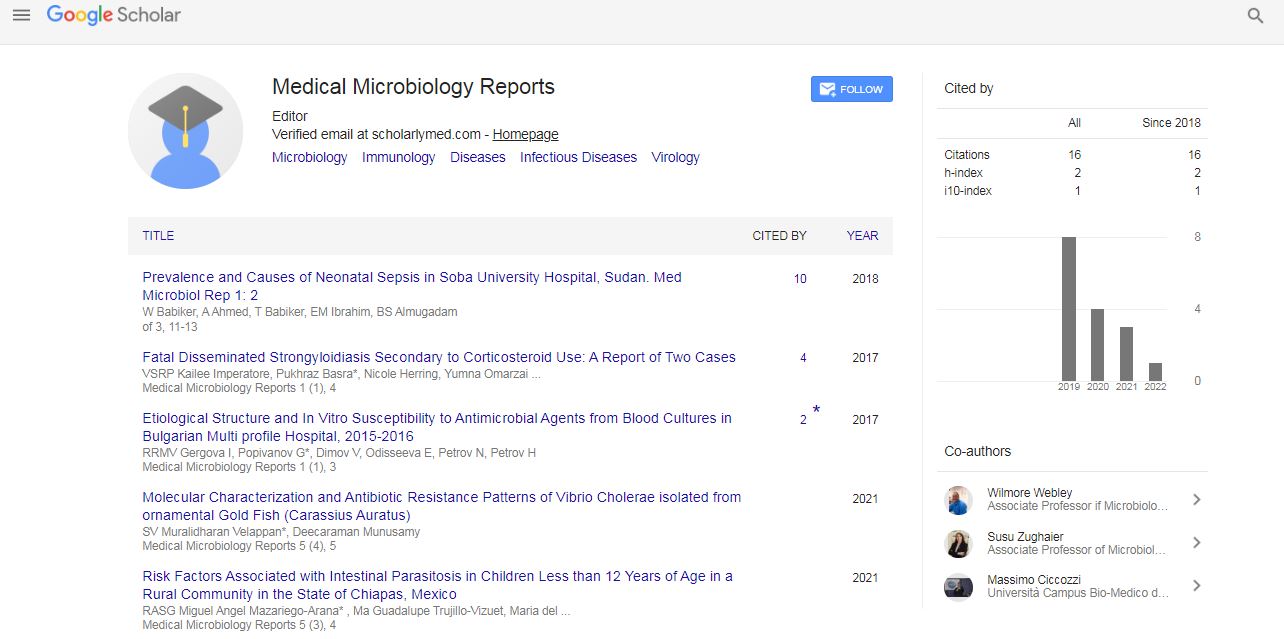Perspective, Med Microbiol Rep Vol: 7 Issue: 2
Ogenic Substances in Medical Microbiology on a Microscopic Scale
Goossens Debourgogne*
Department of Environmental Engineering, Democritus University of Thrace, Xanthi, Greece
*Corresponding Author: Goossens Debourgogne
Department of Environmental Engineering, Democritus University of Thrace, Xanthi, Greece
E-mail: goossdebour@dee.duth.gr
Received date: 22 May, 2023, Manuscript No. MMR-23-107467;
Editor assigned date: 25 May, 2023, PreQC No. MMR-23-107467 (PQ);
Reviewed date: 08 June, 2023, QC No. MMR-23-107467;
Revised date: 15 June, 2023, Manuscript No. MMR-23-107467 (R);
Published date: 22 June, 2023, DOI: 10.4172/mmr.1000345
Citation: Debourgogne G (2023) Ogenic Substances in Medical Microbiology on a Microscopic Scale. Med Microbiol Rep 7:2.
Description
Medical microbiology, the branch of microbiology dedicated to the study of microorganisms and their impact on human health, reveals the intricate connections between microscopic organisms and the human body. Ogenic substances, also known as exogenous substances, refer to chemical compounds produced by microorganisms that can have both beneficial and detrimental effects on human health.
Microscopic organisms, including bacteria, viruses, fungi and parasites, have evolved various mechanisms to interact with their human hosts. Ogenic substances play a vital role in these interactions, as they can influence the virulence, pathogenicity and survival of microorganisms within the human body. These substances may be produced or discharged by microorganisms during infection and can have profound effects on the host's immune response, cell signaling pathways and overall physiology.
One of the most well-known examples of ogenic substances in medical microbiology is the production of toxins by pathogenic bacteria. These toxins, such as those produced by Staphylococcus aureus, Clostridium difficile and Escherichia coli, can cause severe diseases ranging from food poisoning to life-threatening infections. Toxins alter the normal functioning of host cells and tissues, leading to tissue damage, inflammation and disruption of organ systems.
In addition to toxins, ogenic substances produced by microorganisms can also influence the host's immune response. Some microorganisms, like Mycobacterium tuberculosis, produce substances that modulate the immune system, allowing them to evade detection and survive within host cells. These substances can inhibit phagocytosis, alter cytokine production and impair immune cell function, thus enabling the microorganisms to establish chronic infections.
Conversely, ogenic substances produced by certain microorganisms can have beneficial effects on human health. Short-Chain Fatty Acids (SCFAs), such as acetate, propionate and butyrate, are produced by gut bacteria during the fermentation of dietary fibers. SCFAs serve as an energy source for colonocytes, promote the integrity of the intestinal barrier and modulate immune responses. These ogenic substances contribute to maintaining gut homeostasis and play a role in the prevention of diseases, such as inflammatory bowel disease.
Another example of beneficial ogenic substances is the production of Antimicrobial Peptides (AMPs) by certain commensal bacteria. AMPs are small proteins that exhibit antimicrobial activity against a wide range of pathogens. They help to maintain microbial balance on the skin and mucosal surfaces, preventing the colonization of pathogenic microorganisms. Additionally, some AMPs possess immunomodulatory properties, aiding in the regulation of the host's immune response.
The intricate interactions between ogenic substances and the human body extend beyond immunity and disease. Microorganisms can produce metabolites that influence human physiology and contribute to disease development.
The study of ogenic substances in medical microbiology at a microscopic scale poses significant challenges. Many ogenic substances are produced in minute quantities, requiring sensitive analytical techniques for detection and characterization. Advanced mass spectrometry and Nuclear Magnetic Resonance (NMR) spectroscopy techniques allow analysts to identify and quantify ogenic substances in complex biological samples, unraveling their chemical nature and biological effects.
Understanding the role of ogenic substances in medical microbiology has implications for the development of therapeutics and interventions. Targeting specific ogenic substances can offer new avenues for the treatment of infectious diseases.
Conclusion
Ogenic substances play a multifaceted role in medical microbiology, exerting both positive and negative effects on human health. Their production by microorganisms influences host-pathogen interactions, immune responses and physiological processes. By unraveling the intricate interactions between ogenic substances and the human body at a microscopic scale, people can deepen the understanding of infectious diseases, host-microbe relationships and potential therapeutic strategies.
 Spanish
Spanish  Chinese
Chinese  Russian
Russian  German
German  French
French  Japanese
Japanese  Portuguese
Portuguese  Hindi
Hindi 
